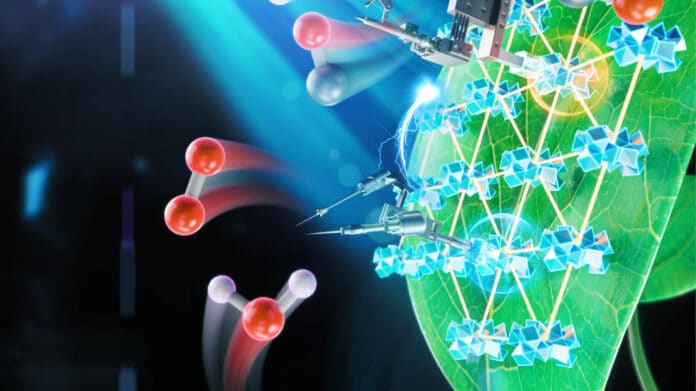For the past two centuries, humans have relied on fossil fuels for energy – hundreds of millions of years of photosynthesis packed into a convenient, energy-dense substance. But this supply is limited, and the consumption of fossil fuels has a tremendous negative impact on Earth’s climate.
One of the possible solutions scientists are exploring is “artificial photosynthesis” – reworking a plant’s system to make our own kinds of fuels. However, the chemical equipment in a single leaf is incredibly complex and not so easy to turn to our own purposes.
Now, chemists at the University of Chicago have devised an innovative new system for artificial photosynthesis that is more productive than previous artificial systems by order of magnitude.
Regular photosynthesis produces carbohydrates from carbon dioxide and water, but artificial photosynthesis could produce ethanol, methane, or other fuels.
“This is a huge improvement on existing systems, but just as importantly, we were able to lay out a very clear understanding of how this artificial system works at the molecular level, which has not been accomplished before,” said a University of Chicago chemist Wenbin Lin and senior author of the study.
“Without natural photosynthesis, we would not be here. It made the oxygen we breathe on Earth, and it makes the food we eat,” said Lin. “But it will never be efficient enough to supply fuel for us to drive cars, so we will need something else.” Lin further added that even nature has no solution for the amount of energy we use. “We will have to do better than nature, and that’s scary,” he said.
Photosynthesis creates carbohydrates, which are great for fueling us, but not our cars, which need much more concentrated energy. So researchers looking to create alternatives to fossil fuels have to re-engineer the process to create more energy-dense fuels, such as ethanol or methane.
Proteins and pigments in the leaf take in water and carbon dioxide, break the molecules apart, and rearrange the atoms to make carbohydrates. However, scientists need to rework the reactions to instead produce a different arrangement with just hydrogen surrounding a juicy carbon core – CH4, methane.
This re-engineering, however, wasn’t easy; people have been tinkering with it for decades. But Lin and his lab team added something that artificial photosynthesis systems to date haven’t included: amino acids. The team started with a type of material called a metal-organic framework (MOF), a class of compounds made up of metal ions held together by organic linking molecules. Then they designed the MOFs as a single layer in order to provide the maximum surface area for chemical reactions and submerged everything in a solution that included a cobalt compound to ferry electrons around. Finally, they added amino acids to the MOFs and noticed that it helped the reaction to be more efficient.
Artificial photosynthesis has a long way to go before it can produce enough fuel. The breakthrough could also be applied widely to other chemical reactions; you need to make a lot of fuel for it to have an impact, but much smaller quantities of some molecules, such as the starting materials to make pharmaceutical drugs and nylons, among others, could be very useful.
Journal reference:
- Guangxu Lan, Yingjie Fan, Wenjie Shi, Eric You, Samuel S. Veroneau, and Wenbin Lin. Biomimetic active sites on monolayered metal-organic frameworks for artificial photosynthesis. Nature Catalysis, 2022; DOI: 10.1038/s41929-022-00865-5
